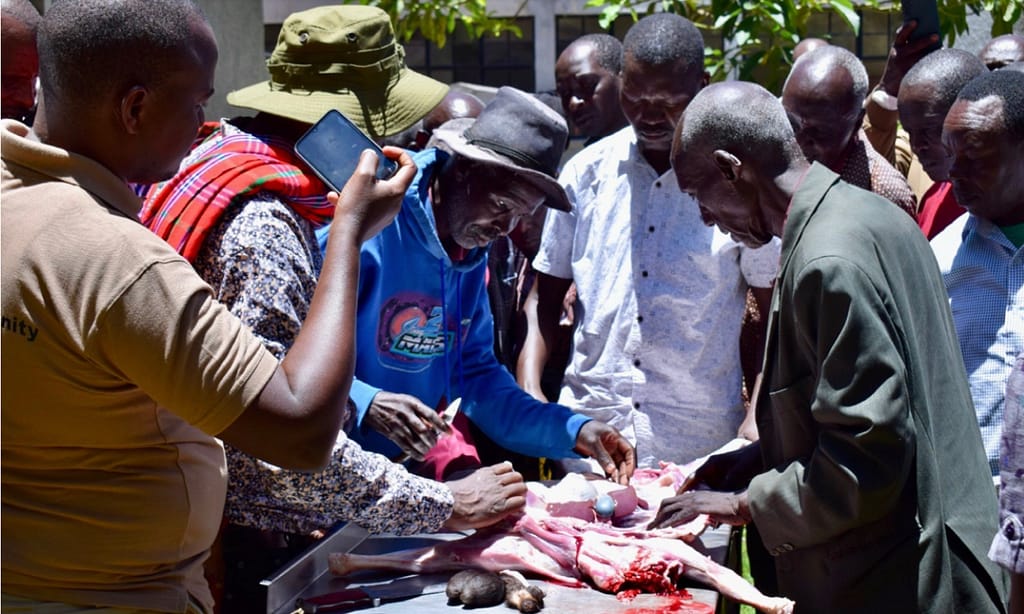By Ellys Mugunda
Dressed in shukas and wielding ceremonial walking sticks, the elders from Samburu community and weather forecast scientists gather beneath the shade of an acacia tree in Loruko village of Isiolo County. This isn’t just any ordinary meeting, but a convergence of tradition and science, where indigenous wisdom meets modern meteorology.
The two groups have converged to compare notes, as a first step towards harmonizing the two approaches to cultivate the community’s confidence and reliability against the backdrop of forecasting uncertainties brought about by a changing climate.
The assignment at hand is to predict weather trends, and when the eagerly awaited outcomes were presented on the third day, scientific prediction and traditional weather pattern indicators were in agreement.
The elders revealed that in making predictions, they rely on knowledge passed through generations, which relies on observing plants and animal behavior, insect movements, the moon, stars, and clouds. While some “advanced” prediction is a reserve of a few families and the talent passed on to offspring, the majority in the pastoralist community are weather experts in their own right.
By merely observing changes in their immediate environment, the community is able to tell with a high degree of accuracy when rain or drought is expected: “A green coloured fly landing on cow dung is a sign of an impending severe drought while massive flowering of acacia munnipellas precedes a season of heavy rains. The presence of dragonflies also heralds a rainy season,” explains John Lengirnas, an elder.

The elder adds that the acacia flowers appear about a month before the onset of the rains, with a set of new flowers appearing every week. When the tree sheds off the last set of flowers by the fourth week, the rains begin.
Only a few individuals are known to have the ability to forecast the future through observation of the stars. The celestial, specifically the positioning and time of appearance, assist in predicting rains and drought: “For the short October to December rains (Ntumurek in Samburu language), we observe the seven sisters stars we call Ngakwa (Pleiads). If they are stuck together and appear in the sky early, like before 8.00pm, it shows that the rains are near and will be heavy. But if the stars delay and come after the expected time, it’s a sign that the rains will be below average,” explains Mzee Lesepen.
Another prediction, which is a reserve of a few, is use of goat’s intestines. Once a goat is slaughtered, an elder studies the appearance of the offal and is able to tell if there will be rains, drought, a raid by rival community to steal livestock, diseases, or death in a particular manyatta (homestead comprising families from the same clan).
During the gathering in Isiolo, three goats were slaughtered and by observing the offal’s, the expert in this field, Mzee Pesika Lerete gave the same verdict each day that rains were expected in a few days but the wet season would not last long.
By observing the tone of blood veins in the offal, resembling rivers and tributaries, Mzee Lerete was able to tell the intensity of the expected rains.
Pattern and movement of migrating wild animals that roam freely in the region has over the years also helped the nomadic community make decisions on which direction to head in search of pasture and water: “One of the reasons why we have concluded that the rainfall we are expecting this season will be inadequate is that elephants are migrating from Isiolo moving towards Laikipia highlands. It is common knowledge amongst us that the huge mammals are capable of ‘smelling the rain’ and naturally head in that direction,” said Nicholas Lesokoyo, a senior elder.
Mzee Lesokoyo says the integration of indigenous and modern ways of weather prediction would inspire confidence among the community to diversify to other sources of income like apiculture or poultry keeping to move away from overdependence on livestock, adversely affected by droughts that are becoming more frequent and lasting longer due to climate change
“With accurate and reliable weather prediction, it will now be easy to convince our people to adopt other ways of livelihood to mitigate against an unfavorable climate. For instance, on the onset of drought, the herders could opt to sell some cows and then restock when the rains come instead of watching in desperation as they are wiped out by drought,” said the elder.
These traditional weather forecasting practices are practiced by most Indigenous communities in Kenya, including Ogiek, Sengwer, Yiaku, Waata, and Awer (Boni), while pastoralists include the Turkana, Rendille, Borana, Maasai, Samburu, Ilchamus, Somali, Gabra, Pokot, and Endorois.
In recognition of the importance of traditional weather forecasts, the Parliamentary Committee on Environment, Forestry, and Mining has proposed incorporating traditional forecasting methods in the Meteorological Bill 2023.
Committee vice chair Charles Kamuren has acknowledged that the methods have been proven to work, and they should therefore be rightfully included in the bill: “The issue of indigenous knowledge is important here. We can’t rule them out. The traditional weather forecast has proven to be accurate. There is a need, therefore, to incorporate it in this Bill.”




